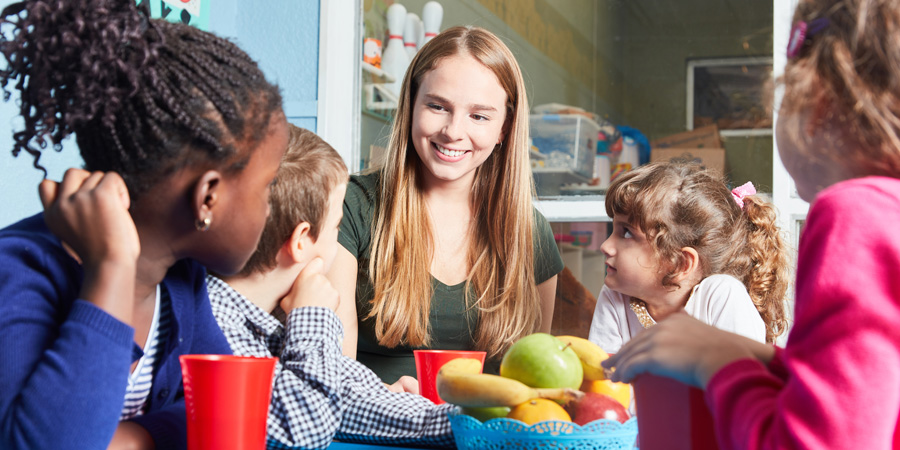Computer games and availability: what works in increasing children’s consumption of fruits and vegetables in school?

Schools are powerful environments for the development of children, and eating behavior is no exception: children from all socio-economic backgrounds mingle in school and can eat up to three meals a day in school (Dudiey et al., 2015, Grosso et al., 2013). Therefore, schools provide an effective setting for educating children about food and nutrition, with school-based nutrition programs having an important impact on child eating behavior and nutrition knowledge (Murimi et al., 2018; Methner et al., 2017; Keihner et al., 2017). Successful school programs, such as providing healthy foods in a familiar way to children, can result in children making healthier food choices and steer away from energy-dense foods that are high in added fat and sugars. This is crucial since these foods can contribute to an energy imbalance that contributes to weight gain and potentially obesity (WHO, 2021), which in turn is significantly associated with adverse school outcomes (Falkner et al., 2001; Datar et al., 2004).
Given the importance of school-based interventions, many of them have been developed and evaluated in the past few decades (Methner et al., 2017; Keihner et al., 2017). A recent review (Verdonschot et al., 2023) has examined what strategies have shown a more positive impact on fruit and vegetable intake and nutrition knowledge.
Providing fruits and vegetables in school is the most effective strategy to increase fruit intake
Many interventions have been implemented to increase children’s fruit and vegetable consumption. Some of them provide fruits and vegetables directly, such as free or subsidized distribution at lunchtime or in small retailers close to the school or providing healthy foods or beverages in the classroom (Evans et al., 2012). Some of the interventions are indirect, focusing on increasing the availability of fruits and vegetables in cafeterias or vending machines without providing it directly (Micha et al., 2018).
These interventions were especially effective in increasing fruit consumption, with positive effects in 5 studies with over 10.166 participants in total (Moore and Tapper, 2008; Bere et al., 2010; Fogarty et al., 2007; Eriksen et al., 2003; Ashfield-Watt et al., 2009). Concerning vegetable consumption, some studies showed positive effects, with one showing an increase of 20.7g/day (Tak et al., 2007), yet other studies showed negative effects (Bere et al., 2010, Eriksen et al., 2003).
Online games and activities to increase children’s vegetable intake
As children spend more and more time on the internet, researchers are profiting from this means to try to educate children in nutrition and healthy eating in an entertaining way. To do so, different strategies have been used, including online questionnaires with feedback (Evans et al., 2012), online resources to be accessed by students at home or at school (Dudiey et al., 2015), or educational games (Silveira et al., 2011). One example is the game “Squire’s Quest!”, which includes challenges to eat more fruits, 100% fruit juice, and vegetables, as well as virtual cooking sessions to teach them healthy recipes (Baranowski et al., 2003)
And it works: using online games and activities increased the quantity of vegetables that children consumed, based on multiple studies with a total sample size of 2211 (Baranowski et al., 2003; Mangunkusumo et al., 2007; Amaro et al., 2006). The effect on fruit consumption was not that clear, showing mixed effects. The game “Squire’s Quest!” was particularly effective in increasing fruits and vegetables consumption, with children who participated in the program increasing their consumption one serving more than children who did not participate.
Multiple interventions simultaneously are more effective than individual strategies alone
Increasing availability of fruits and vegetables in school, as well as creating online games and activities effectively increase the amount of fruit and vegetables that children eat at school and even at home. Yet why stop at one strategy when you can implement more of them at the same time? Indeed, joining forces and applying more than one strategy at the same time has proven to be the most effective way of increasing fruit and vegetable consumption in children (Van Cauwenberghe et al., 2010; Evans et al., 2012; Murimi et al., 2018). Specifically, the most effective are combinations of (1) education components, targeting school children directly; (2) environmental components, targeting the school environment, including the school canteen and school staff but not students; and (3) parental and family components, which involve parents to reinforce the school intervention.
Reviews such as the one in hand (Verdonschot et al., 2023), shedding some light on how effective individual components, as well as reviews researching effectiveness of multiple component interventions (Evans et al., 2012; Micha et al., 2018), allow the development of public policies armed with science-based evidence. Indeed, a toolkit was developed in 2016 by the Joint Research Center (the European Commission’s in-house science service; Mak et al., 2016) providing schools with recommendations on how to increase fruit and vegetable consumption. It is the analysis of these interventions that direct the development of public policies towards the most effective action levers, allowing schools to promote fruit and vegetable consumption more effectively.
Based on : Verdonschot, Angeliek, et al. “Effectiveness of school-based nutrition intervention components on fruit and vegetable intake and nutrition knowledge in children aged 4–12 years old: an umbrella review.” Nutrition Reviews 81.3 (2023): 304-321.
- Providing fruits and vegetables in school is the most effective strategy to increase fruit intake.
- Online games and activities are effective as a means to increase children’s vegetable intake.
- Multiple interventions simultaneously are more effective than individual strategies alone.
